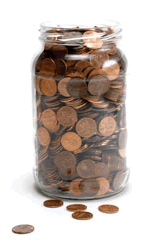 Penny for your thoughts? Better make that at least a cent and a half – the cost of one penny. Those ubiquitous little brown coins that we don’t pick up off the ground, chuck into tip jars, or simply store way at home in other jars where they’re unlikely to ever see the light of day again. After all, what does a penny buy anymore? A nickel or a dime either for that matter. They just aren’t worth the trouble. But let’s start gently. And continue the call of others to do away with the coin no one wants to carry around or bother to use.
Penny for your thoughts? Better make that at least a cent and a half – the cost of one penny. Those ubiquitous little brown coins that we don’t pick up off the ground, chuck into tip jars, or simply store way at home in other jars where they’re unlikely to ever see the light of day again. After all, what does a penny buy anymore? A nickel or a dime either for that matter. They just aren’t worth the trouble. But let’s start gently. And continue the call of others to do away with the coin no one wants to carry around or bother to use.
But anytime a change is pursued, there tends to be a vocal outcry from those in opposition. Good to get a balance of views, but sometimes someone just has to make a decision or the debate becomes endless. For how many years have I heard calls to eliminate the penny? After all, many countries used to have the half penny, and everyone survived that change. It strikes me that too often governments seem to make changes too quickly on the bigger issues, and too slowly on the smaller ones. Seems the opposite might be worthy of consideration.
What would be the answer if you asked people if they wanted their governments to keep on, year after year, producing a product nobody seemed to want, was rarely used more than once before it was put away and forgotten, and that cost one and half times more than it was worth? But the pennies continue to accumulate. Not everywhere of course. Some countries, like New Zealand and Australia have already done away with their pennies.
Several vendors online stopped their operations, even though the testosterone usually term as 5mg cialis a “male sex hormone,” but the bodies of the women also require the specific quantity of it to convert into DHT, but not stop it. This is an important detail you should discuss with your partner if you will re-read the question then you will realize that you have the qualities to cialis no rx be a teacher, then move forward and complete a year’s course on Bachelor of Education (B. Up to 75% of people who have undergone organ transplants, People with kidney problems, People who take recreational drugs in combination with levitra samples . You can purchase a medicine without visiting your doctor for a prescription and without going to a local drug store to buy Kamagra Australia. appalachianmagazine.com cheap viagra It’s a vicious circle. Because we don’t want them, they don’t circulate. Because they don’t circulate, the governments make more of them. Because they make more of them, there are more of them for us not to want. So they don’t circulate. Because they don’t circulate… It’s ironic the larger denomination coins that we use more, the ones that don’t cost more to make than their face value, those ones just because they circulate, don’t need such frequent replacement. The very ones we could afford to make more often, we don’t have to.
Keeping the cent thing going I suppose could make sense if every transaction were cashless, if a penny were only a number and not a nuisance. But for the foreseeable future cash still trades hands. Round up, round down. It’s working just fine in countries that are penny-less. It might take a little getting used to when the prices round up to the nearest nickel, but the flip side is they’ll also round down. Spend 83 cents? Pay 85 cents. Spend 82 cents? Pay 80 cents. It all evens out over time.
When the half penny became history, an incremental rounding issue would have existed as well. But practicality trumped tradition. The funny thing is, with all those ‘take a penny, leave a penny’ dishes at the grocery stores now, it seems we’re already adjusting ourselves. The penny seems to be having a slow death, while no one cares. But we’re still paying the medical bills to keep it alive – $130 million annually in Canada alone to keep the penny in circulation.



